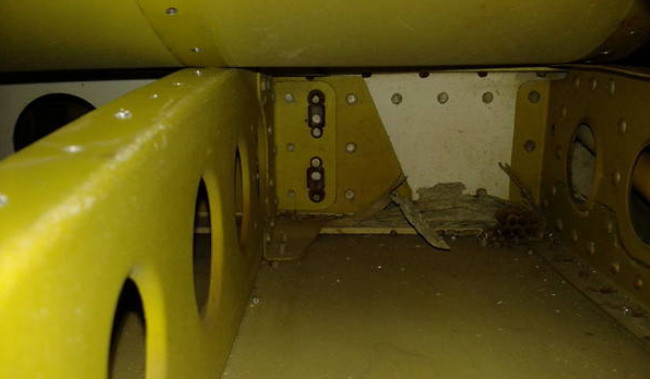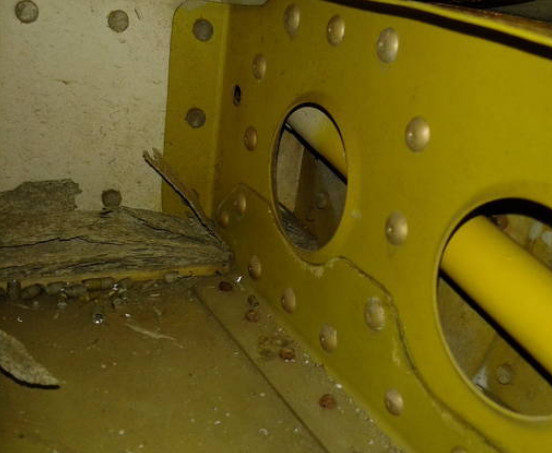If my HS was corroding on the inside, I would want to know and get it fixed. I would prefer not to be flying around in ignorance. The only way to know is to look. The initial hole-drilling and inspection doesn’t seem like that big a job. Obviously, it becomes a much bigger job if corrosion is found.
Now I’m wondering how they found the problem in the first place. Was there an accident? Or was it obvious at the Annual? Maybe that’s what I’m missing…
It is not about ignoring it. You can see corrosion with a borescope.
Drilling all rivets and damaging the skin if you drill too far or not careful enough is stressing the material.
Also bending it open stresses the material.
I fully accept and acknowledge that. But removing and bending the skin only needs to happen if corrosion is found by the inspection.
Or have I misread it?
This is what happened with Commanders. You have to drill the rivets and open it to look inside, then close it if nothing found. Repeat that every 150hrs.
That sounds like a raw deal for Commander owners. You’d think that whoever signs these things off would have asked why a simpler procedure could not be found – though at least the FAA seems quite pragmatic when it comes to approving an AMC.
The AD for the TB-fleet referred to by Peter does not require such an invasive procedure unless corrosion is found by the inspection and at that point you need to effect a repair (hopefully), so I can understand the need for drilling the rivets.
The AD for the TB-fleet referred to by Peter does not require such an invasive procedure unless corrosion is found by the inspection and at that point you need to effect a repair (hopefully), so I can understand the need for drilling the rivets.
If that is the correct interpretation of the AD, that is OK, but -
The best inspection procedure is to drill holes in the tip ribs, along their centreline where there is zero stress. Then one can see all the internals very clearly. You can do it with a €300 Ebay-chinese flexible endoscope.
However you can also do it via the holes which become accessible in the middle, when the elevator is removed from the aircraft. No drilling of anything anywhere! But you need a ~2m endoscope and it is fiddly. This has been pointed out to Socata but meaningful communication with them is very difficult nowadays.
The inspection holes which the Socata SB specifies don’t actually help much, though they were probably intended for the old-fashioned borescope for inspecting cylinder bores, which can see only sideways, and can’t see anything much beyond about 30cm. Those holes allow the inspection of only the central part of the spars, which is practically “OK” because there is where most of the stress is.
Now I’m wondering how they found the problem in the first place. Was there an accident? Or was it obvious at the Annual? Maybe that’s what I’m missing…
I am not aware of an actual crash but it started with a guy posting on the Socata owners forum (registration is free but the server owner has to approve you personally) a couple of years ago, reporting a severely corroded TB9 stabiliser. He posted some scary photos of severe exfoliation of the spars. Then there was him or someone else reporting that when they looked at scrapyards for a replacement they found every one similarly corroded. I made contact with the guy (in the USA) but the communication thereafter became, ahem, difficult… I guess he regretted having drawn attention to himself (the usual GA problem with researching almost anything). But he said it’s OK to use the photos:


Then there was somebody else saying the same…
My feeling was that this had the potential for an AD grounding all TB aircraft, pending an inspection, and I asked Socata about the cost, which was c. €7k (plus VAT, painting, and it doesn’t come with the trim tab components). That “grounding” is what we now have (not N-reg though although you would be nuts to not do the €300 Ebay endoscope check). But a lot of people reported zero corrosion, so it appears to be highly localised in the TB population. My suspicion, as I wrote earlier, is that the dodgy tie-back of the controls is possibly the reason. On a TB this is stupid because there is a feature in the LHS yoke tube which locks everything in a neutral position. I don’t know if the older TBs have that control lock…
And anybody doing ACF50 from the start will have zero corrosion anyway – the stabiliser is absolutely dead easy to do with the 4mm diameter 2m long spray nozzle. There are various holes… but if you drilled the tip ribs as mentioned above then it is a 60 second job.
Obviously, if you find anything like the above pics, the whole thing is scrap and you have to join the queue at Tarbes. I have no idea what the supply situation is.
Thank you very much for elaborating, that was very interesting. It’s a shame that Socata ignored the alternative, easier and less invasive inspection procedures.
Scary photos indeed. I hope there are not many affected like that. I imagine the number of airframes which have had continuous ACF50 protection from day 1 is regrettably small – though probably a higher proportion of one-owner machines – but I would like to be proved wrong.
Where was that thread on sailing? I might take that up instead… 
That US pilot said his plane had the full factory anti corrosion treatment (whatever it was… LPS-something??) but obviously there is zero evidence of anything having been applied to the inside of his stabiliser.
I am not aware of anything that actually “gets in there” and works properly, apart from ACF50 and their arch-rival Corrosion-X.
In Europe, C-X seems to have a much lower profile; it seems to have been marketed a lot less. I bought a used C-X spray kit – same as the one used for ACF50.
I think you will find that corrosion in sailing is worse – it is guaranteed 
there is a feature in the LHS yoke tube which locks everything in a neutral position. I don’t know if the older TBs have that control lock…
Our 1990 TB20 also has the simple control lock on the LHS Yoke tube too.
Peter wrote:
hat US pilot said his plane had the full factory anti corrosion treatment (whatever it was… LPS-something??) but obviously there is zero evidence of anything having been applied to the inside of his stabiliser.
“Full Factory anti-corrosion” used to be be zinc chromatic based paint and in the last 10 years or so, epoxy coatings, are applied on all the parts before assembly.
Oil based after-market “treatments” are just that and are no where near as effective long term as the former.
The stab in the photo appears to have been assembled with zinc chromate parts but the rear spar is bare – maybe a “line” repair ?